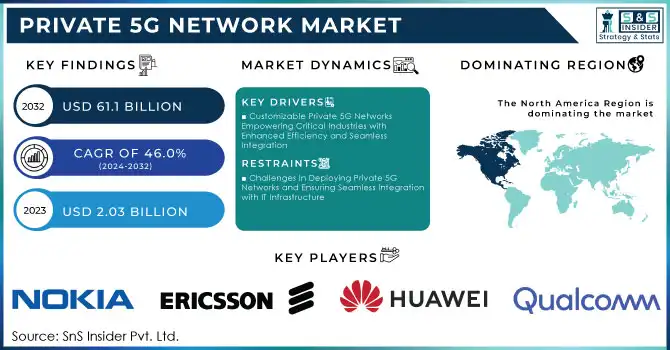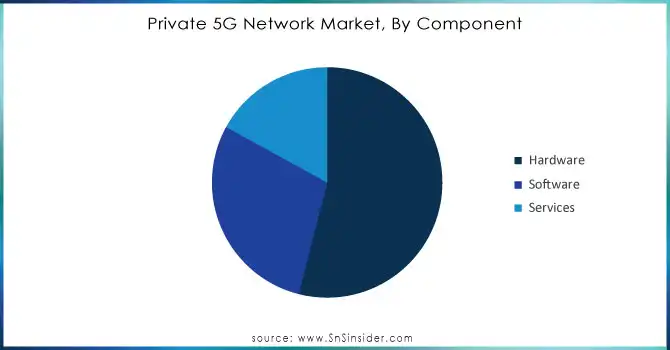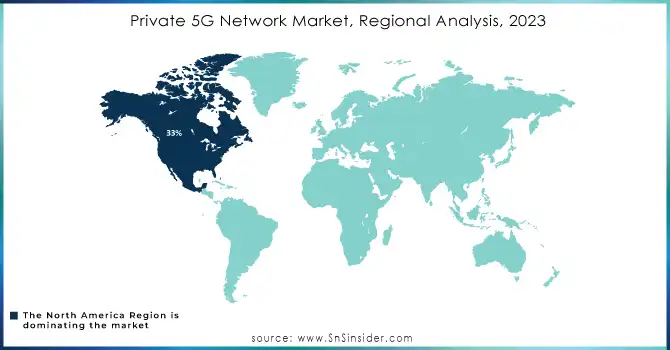Private 5G Network Market Size & Overview:

To Get More Information on Private 5G Network Market - Request Sample Report
The Private 5G Network Market Size was valued at USD 2.03 billion in 2023 and is expected to reach USD 61.1 billion by 2032, growing at a CAGR of 46.0% over the forecast period 2024-2032.
The growth in the private 5G network market is robust mainly due to the growth of government efforts and enterprise digitalization. Across the globe, regulators are preparing spectrum availability and establishing frameworks to allow for private 5G deployments at the very minimum price via band arranging. The Federal Communications Commission (FCC) has opened up mid-band spectrum in the U.S. for enterprise 5G applications. Incentives for enterprises, meanwhile, have been offered to spur the development of private 5G networks, to bolster critical connectivity infrastructure. The Commission found that, across Europe, private 5G network projects have grown dramatically, particularly for productivity improvements in manufacturing and healthcare. The Commission allocated €1 billion for 5G innovation in industrial hubs through its 2023 Digital Decade initiative, reflecting the emphasis on digital transformation.
In Asia, the Indian Department of Telecommunications revealed the allocation of 720 MHz spectrum for the deployment of private 5G networks. Such initiatives are likely to have a profound impact on sectors such as logistics, smart factories, and health care by facilitating automation and improved connectivity. At the same time, the Chinese Ministry of Industry and Information Technology (MIIT) reported an increase of 30% for private 5G deployments in 2023 as Chinese Government subsidies were covering 50% of the deployment costs. Together, these initiatives underscore the importance of government assistance in facilitating the uptake of private 5G. As organizations take to Industry 4.0 technologies, private 5G networks have come into view as vital to an operational efficiency and innovation agenda. Ultra-low latency and enhanced connectivity capabilities delivered by the networks enable enterprises to power automation, robotics, and IoT at scale. According to a 2023 report by the International Telecommunication Union (ITU), businesses utilizing private 5G networks had witnessed a 30% enhancement in operational efficiency with reduced downtime and improved productivity standing out as important advantages.
Private 5G Network Market Dynamics
Drivers
-
Private 5G networks enable real-time monitoring and control, which is critical for automation in industries such as manufacturing and mining. Companies leverage 5G for remote operations, reducing workforce requirements, and improving safety and efficiency.
-
Applications requiring low latency, such as remote surgery or autonomous vehicle systems, are driving demand. The reliability of private 5G networks makes them indispensable for such critical operations.
5G is transforming industrial automation, allowing for real-time control and monitoring of operations. The ultra-reliable, low-latency communication (URLLC) offered by private 5G is critical for high-stakes environments like manufacturing, mining, and logistics. Epiroc, a Swedish company that specializes in mining equipment, teamed up with Ericsson to implement private 5G solutions to automate mining facilities to the next level, for example in Sweden. High-precision positioning networks for the support of remote control of heavy machines, which increases safety and efficiency. Awareness of this use case is growing since, for example, in May 2024, Tesla implemented a private 5G network in the Berlin Gigafactory. The network powers things like wireless updates for hundreds of cars and automated logistics systems. According to reports, the deployment has reduced more than 90% of the overcycle issues in the general assembly shop. The same for Qatar where Hamad Port has used private 5G to innovate remote control of port cranes and gantries. The change has led to greater efficiency and lower operational risk.
In the energy sector, Shanxi Coking Coal Group in China deployed private 5G with 4K cameras and sensors for underground operations. This led to safer working conditions for workers and reduced workforce on site, in addition to process efficiency. These advancements highlight how essential is Private 5G; one of the building blocks of industrial innovation providing enterprises with a unique opportunity to enhance efficiencies and ensure superior safety in challenging environments.
Restraints
-
The high cost of infrastructure and setup, especially for enterprises not heavily reliant on data-driven operations, limits widespread adoption.
-
Regulatory challenges and spectrum allocation issues in different regions create barriers to smooth implementation, especially for new entrants.
The absence of spectrum availability continues to pose a major constraint over private 5G network growth. Governments and regulatory bodies control access to the spectrum, which is often limited, contested, or inconsistently managed across regions. Enterprises aiming to deploy private 5G must navigate complex licensing requirements, which can delay projects and increase operational burdens. For example, some countries set aside designated spectrum bands for industrial 5G, while others require at least some enterprises to use bands shared with public networks, raising the specter of interference and poor network reliability. This absence of harmonization poses difficulties for MNCs looking for consistent deployments across borders. In addition, spectrum auctions can be too costly; this limits who can participate in the market, favoring larger firms over smaller firms. Such barriers not only hinder the ubiquitous implementation of private 5G but also change the very nature of innovation across industries like manufacturing and logistics that could be transformed by such networks.
Private 5G Network Market Segment Analysis
By Component
The hardware segment dominated the market and held the highest share of 54% of the total revenue in 2023. This is due to heavy investments in core network infrastructure such as base stations, antennas, routers, and edge devices. Infrastructure hardware underpins private 5G networks and allows enterprises to implement the kind of efficient and high-throughput connectivity solutions required for them. The Ministry of Science and ICT in South Korea stated that the total export of 5G hardware in 2023 rose by 22 percent as the demand for high-performance components continues to rise in the global market. The massive MIMO (Multiple Input Multiple Output) antennas and beamforming based on 5G technology advancements in the hardware segment have greatly benefitted network performance.
The governments have significantly contributed to the growth of this segment by providing financial assistance for the deployment of 5G hardware. The Chinese government, for example, has subsidized 40% of hardware expenses for enterprises embracing private 5G networks, allowing SMEs (SMEs) to adopt these technologies. Likewise, Germany's Federal Ministry for Economic Affairs and Climate Action introduced a program supporting grants for 5G hardware infrastructure on industrial sites. Such measures are designed to mitigate the upfront costs of investment by enterprises and drive adoption across the community.

Need any custom research on Private 5G Network Market - Enquire Now
By Frequency
In 2023, the Sub-6 GHz segment dominated the Private 5G Network Market, as it offers the trade-off between optimal coverage and performance. The ultimate coverage of this frequency band that covers 450 MHz to up to 6 GHz is well-known and the cost of deployment is relatively low compared to mmWave frequencies. Based on the GSMA’s Mobile Economy 2023 Report, the vast majority (70%) of private 5G networks that have been deployed globally, have been deployed with Sub-6 GHz frequencies. Such deployments were clustered around sectors like manufacturing, logistics, and utilities that demand wide-area coverage from sprawling operational footprints.
Sub-6 GHz frequencies had a big boost from governmental initiatives. In 2023, the FCC dedicated over 200 MHz of Sub-6 GHz spectrum for the development of private 5G networks in the United States. In Japan, the Ministry of Internal Affairs and Communications (MIC) also announced an early release of Sub-6 GHz spectrum for industrial use, with targeted applications including smart factories and logistics hubs. In Asia-Pacific, governments are opening up the spectrum to accelerate the digital transformation of important economic sectors, so this frequency band is also of interest.
By Spectrum
The unlicensed/shared spectrum sector dominated the private 5G network market in 2023 as a favorable regulatory environment allows access to cost-effective spectrum. In the U.S., the Citizens Broadband Radio Service framework has allowed enterprises to run shared spectrum 5G networks without heavy licensing fees, making private 5G networks increasingly feasible to deploy. In 2023 alone, the FCC issued more than 5,000 CBRS licenses across a range of sectors, including education, healthcare, and logistics.
In Europe, Ofcom's Shared Access Licensing model has increased spectrum availability for private 5G networks, especially for small and medium enterprises. It has lowered the barrier for businesses that can take advantage of 5G connectivity to leverage for use cases such as remote monitoring, predictive maintenance, and more. Shared spectrum enables fast and low-cost network deployment by enterprises, thus preferred among the inexpensive vertical segments.
By Vertical
In 2023, the manufacturing and factories segment accounted for a major share of the Private 5G Network Market, with over 35% share. Private 5G networks in this domain have been utilized to improve operational efficiency via automation, IoT integration, and real-time analytics. As per the 5G Campus Network Program of Germany, more than 500 plants adopted private 5G networks in 2023, with the help of government subsidies offsetting as much as 30% of the deployment cost.
The Ministry of Commerce and Industry of India reported a 40% growth in robotics, predictive maintenance, and quality assurance processes in factories due to private use of the 5G network. These networks have helped implement near real-time monitoring, which has helped in reducing downtime by 25% and overall productivity by 20%. The use of private 5G networks by the manufacturing sector is sure to increase further, as industries adopt Industry 4.0 technologies to stay competitive.
Private 5G Network Market Regional Analysis
In 2023, North America accounted for more than 33% share of the global revenue in the Private 5G Network Market and was the largest region. This is due to favourable regulatory frameworks, as well as strong government support for private 5G infrastructure development and deployment. A lot of this growth can be attributed to the Federal Communications Commission (FCC) and its Citizens Broadband Radio Service (CBRS) availability, which enables enterprises to obtain access to shared spectrum at a much lower cost. But this has removed barriers and allowed more opportunistic and widespread adoption of private 5G networks with different verticals. Technology providers and enterprises have also invested significantly in the region to develop 5G solutions in the industrial domain. The U.S. Department of Commerce estimates that private 5G networks have improved operational efficiency, accounting for a 15% boost in industrial productivity in areas like manufacturing, logistics, and health care. This upgrade is due to the capability of 5G networks to enable real-time data exchange, IoT integration, and automation. These innovations allow North America to lead the way in delivering new private 5G applications.
The Asia-Pacific region is expected to grow at the fastest CAGR during the forecast period. Governments in countries like China, Japan, and India are aggressively promoting private 5G adoption through spectrum allocation and financial incentives. For instance, the Indian government allocated $1.2 billion in 2023 to subsidize private 5G deployments, focusing on manufacturing, logistics, and smart cities. Similarly, China deployed over 1,500 private 5G networks in industrial parks in 2023, supported by its "Made in China 2025" initiative.

Recent Developments in the Private 5G Network Market
-
Ericsson partnered with Orange in December 2023 to deliver private network solutions over 5G as a service to B2B customers, enabling enterprises with a flexible connectivity service that can be tailored to meet complex operational requirements.
-
In February 2024, the FCC unveiled an expanded spectrum for private 5G networks geared at smart cities and healthcare innovation.
Key Players
Service Providers / Manufacturers:
-
Nokia (AirScale Baseband, Digital Automation Cloud)
-
Ericsson (Ericsson Private 5G, Radio Dot System)
-
Huawei Technologies (5G CPE Pro, 5G Core Network)
-
Qualcomm Technologies, Inc. (FSM100xx Platform, Snapdragon X75 5G Modem)
-
Samsung Electronics Co., Ltd. (Compact Core, Massive MIMO Solutions)
-
Cisco Systems, Inc. (Cisco Ultra-Reliable Wireless Backhaul, Catalyst 5G Routers)
-
ZTE Corporation (5G Radio Access Network, ZTE's Digital Core)
-
Juniper Networks, Inc. (Mist AI for 5G, Contrail Networking)
-
Dell Technologies (Dell EMC PowerEdge Servers, Dell Open RAN Solutions)
-
Hewlett Packard Enterprise (HPE) (HPE Edge Orchestrator, HPE Aruba)
Key Users
-
General Motors
-
Boeing
-
Siemens AG
-
ABB Group
-
Volkswagen Group
-
Tata Steel
-
Foxconn Technology Group
-
Samsung Heavy Industries
-
Pfizer Inc.
-
Maersk Group
| Report Attributes | Details |
| Market Size in 2023 | US$ 2.03 Bn |
| Market Size by 2032 | US$ 61.1 Bn |
| CAGR | CAGR of 25.46.0% from 2024 to 2032 |
| Base Year | 2023 |
| Forecast Period | 2024-2032 |
| Historical Data | 2020-2022 |
| Report Scope & Coverage | Market Size, Segments Analysis, Competitive Landscape, Regional Analysis, DROC & SWOT Analysis, Forecast Outlook |
| Key Segments |
• By Component (Hardware, Software, Services)
• By Enterprise Size (Small & Medium Enterprises, Large Enterprises) • By Frequency (Sub-6 GHz, mmWave) • By Spectrum (Licensed, Unlicensed/Shared) • By Vertical (Manufacturing/Factories, Energy & Utilities, Transportation & Logistics, Defense, Enterprises & Campus, Mining, Healthcare/Hospitals, Oil & Gas, Retail, Agriculture, Smart Cities, Others) |
| Regional Analysis/Coverage | North America (US, Canada, Mexico), Europe (Eastern Europe [Poland, Romania, Hungary, Turkey, Rest of Eastern Europe] Western Europe] Germany, France, UK, Italy, Spain, Netherlands, Switzerland, Austria, Rest of Western Europe]), Asia Pacific (China, India, Japan, South Korea, Vietnam, Singapore, Australia, Rest of Asia Pacific), Middle East & Africa (Middle East [UAE, Egypt, Saudi Arabia, Qatar, Rest of Middle East], Africa [Nigeria, South Africa, Rest of Africa], Latin America (Brazil, Argentina, Colombia, Rest of Latin America) |
| Company Profiles | Nokia, Ericsson, Huawei Technologies, Qualcomm Technologies, Inc., Samsung Electronics Co., Ltd., Cisco Systems, Inc., ZTE Corporation, Juniper Networks, Inc., Dell Technologies, Hewlett Packard Enterprise (HPE) |
| Key Drivers |
• Private 5G networks enable real-time monitoring and control, which is critical for automation in industries such as manufacturing and mining. Companies leverage 5G for remote operations, reducing workforce requirements, and improving safety and efficiency.
• Applications requiring low latency, such as remote surgery or autonomous vehicle systems, are driving demand. The reliability of private 5G networks makes them indispensable for such critical operations. |
| Market Restraints | • The high cost of infrastructure and setup, especially for enterprises not heavily reliant on data-driven operations, limits widespread adoption. • Regulatory challenges and spectrum allocation issues in different regions create barriers to smooth implementation, especially for new entrants. |

